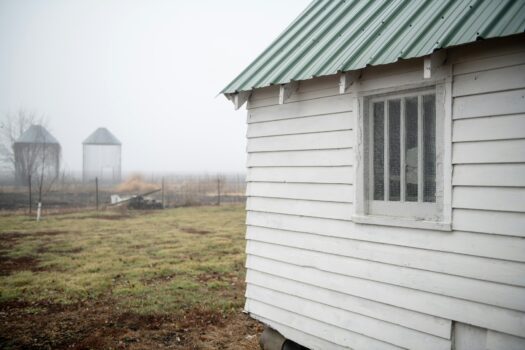Minnesota’s climate, with its brisk winters and pleasantly warm summers, presents a unique canvas for homeowners, especially those living in the rustic charm of an old farmhouse. The state of Minnesota is a testament to nature’s diverse conditions, serving up a variety of weather conditions that can range from sub-zero chills to the golden warmth of a midsummer day. Such a broad spectrum of temperatures not only shapes the culture and lifestyle of Minnesotans but also deeply influences the approach one must take toward air conditioning and an aged farmhouse.
The Challenges Facing an Old Farmhouse HVAC Project
Old Farmhouse Anatomy
Air conditioning an old farmhouse in Minnesota has a variety of challenges. Firstly, it is the old farmhouse itself, its structure and design. Secondly, the weather extremes that the state of Minnesota is well known for, which can cause a lot of issues with even the most robust hvac systems.
Firstly, the very anatomy of an old farmhouse often presents the initial obstacle. Thick walls, constructed long before the discovery of modern insulation practices, can be both a blessing and a curse. They provide natural insulation but complicate the installation of ductwork necessary for central air systems. The task of integrating contemporary systems without compromising the structural integrity or the aesthetic appeal of these homes requires a careful approach.
In addition, the lack of existing ductwork, which is the case in almost all old farmhouses, means that installing a traditional HVAC system may involve extensive remodeling. This increases the complexity of the project. That is not all, as it also drives up the potential upfront cost. Such a dilemma faces a lot of homeowners, as they weigh the need for modern comfort with the great upfront costs.
Weathering the Extreme Climate
The climate in Minnesota presents a unique puzzle for homeowners aiming to install air conditioning in their old farmhouses. The temperature in the state is known for being scorching hot during the month, and freezing cold during the winter months. Therefore, the chosen HVAC system has to be resilient and able to adapt to these varying conditions.
Cost-Effectiveness and Efficiency Challenges
Energy efficiency is another significant concern. Older homes were not designed with today’s mindset. Therefore, ensuring that the AC system operates efficiently is a challenge, not just for the sake of reducing utility bills but also in an effort to minimize the environmental footprint. This often means that additional work, such as updating windows and adding insulation, is necessary to prevent the newly conditioned air from seeping out through the many openings and drafty areas that are part of an old farmhouse’s charm.
Premier HVAC Systems for the Minnesotan Farmhouse
Selecting the right HVAC system for a farmhouse in Minnesota requires careful consideration. The system must be robust enough to combat the state’s extreme challenges.
Heat Pumps
HVAC systems offer innovative solutions that align seamlessly with Minnesota’s distinctive climate fluctuations. Geothermal heat pumps are one of the methods that taps into the earth’s consistent subterranean temperatures to deliver both warmth and coolness with remarkable efficiency. Additionally, you can couple it with the concept of multi-zone systems, offering the flexibility to customize indoor climates across different sections of a residence.
High-Efficiency Gas Furnaces
In the quest to equip an old farmhouse with the means to withstand Minnesota’s notoriously icy winters, gas furnaces are always a great choice. These units are lauded for their ability to confront the plummeting temperatures that often ambush the region unexpectedly.
Can You Add Air Conditioning to Existing Gas Furnace?
When it comes to augmenting the capabilities of an existing gas furnace, there is good news. Your trusty gas furnace can be partnered with an air conditioning unit to build a comprehensive climate control system. Such a pairing ensures you can maintain a comfortable indoors temperature regardless of the whims of external temperatures.
Ductless Mini-Splits
Non-invasive solutions are always on the top of the list as they allow for keeping a balance between the aesthetic of the old rustic farmhouse, while providing it with modern HVAC solutions. So if you ever dreamt of robust AC systems that do not require any ducts, then the answer to your prayers is none other than ductless mini splits.
These units provide targeted cooling across various zones of the home, bypassing the need for comprehensive duct installation and maintaining the architectural identity of the residence. Therefore, you will easily be able to provide heating and cooling to different zones in your house without the need for ugly ducting that might not fit well with the aesthetic of the old and rustic farmhouse.
Sealing the Deal – Energy Efficiency and Advanced Solutions
Ensuring that your farmhouse is well-sealed is similar to buttoning up a warm coat against Minnesota’s biting winter winds. Sealing leaks and ensuring proper insulation are essential in making your HVAC system work efficiently. Weatherstripping, caulking, and upgrading window and door fixtures can make a significant difference in how well your home maintains its internal climate. For instance, upgrading windows and doors to be double-panned will do wonders in terms of insulation. It will help you year-round, trapping the warmth inside during the winter and preventing heat transfer from outside during the summer.
Energy efficiency is not just a buzzword but a critical aspect of modern HVAC systems. The ANSI sets forth standards that guide the design and performance of HVAC equipment, ensuring that systems not only perform well but also contribute to energy conservation.
Modern HVAC technology has introduced a selection of advanced tools that revolutionize the way homeowners manage their indoor environments. For example, smart thermostats and integrated home automation systems represent the cutting edge of this domain. They extend the power of control to homeowners, even when they’re away. So while your farmhouse might be rustic and old, your HVAC systems do not have to be, this is the beauty of integrating technology and smart systems with rustic and historic architecture.








